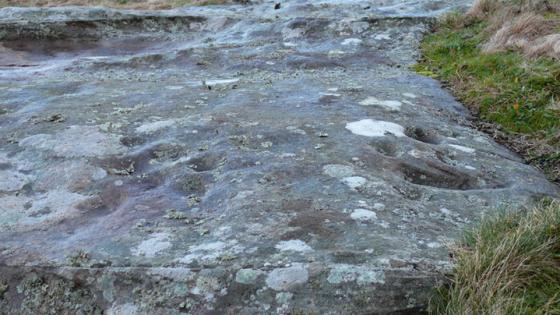
Taken 16-3-2002CE.

Taken 16-3-2002CE.
As regards the King’s Stone, which members had viewed that morning, it had really nothing to do with the battle [of Flodden]. It was, in fact, a very ancient Tribal Gathering or Trysting Stone, which had evidently been transported from the cherty magnesian limestone quarry at Carham, either mechanically or by glacial action.
The prevailing misapprehension about the King’s Stone has probably been perpetuated by, if it did not originate in, Scott’s Notes to Marmion – “An unhewn column marks the spot where James fell, still called the King’s Stone.” As a matter of fact it is situated about three-quarters of a mile Northward from the locality of the final scene of the battle, on the farm of Crookham Westfield, formerly a Moor.
There is interesting incidental evidence that just thirty-two years after Flodden, this rugged column was known as the Standing Stone. The Earl of Hertford, on one of his expeditions into Scotland, left Newcastle in September 1545, “and all his army had a day appointed to mytte at the Stannyngston on Crocke-a-More (Crookham Moor).”
From volume 10 of the History of the Berwickshire Naturalists’ Club (1908).
An earlyish mention of the legend, and it’s sort of interesting that there’s another stoney place involved in the story:
We now turn southward on the Etall-road from Cornhill, about two miles from which, on the right hand, in Brankston-west-field, is a large upright pillar, of whinstone, six feet, seven inches high, and thirteen feet in diameter towards the base; a memorial of the great victory obtained over K. James IV, of Scotland, by the Earl of Surrey, on Friday, 9th of September, 5[sic] K. Henry VIII, 1513.
This battle is called, The battle of Brankston, from the chief scene of action being near that village; also the battle of Floddon from the Scotch intrenchments being on Floddon-hill, out of which they were drawn forcibly, as it were, to an engagement, by the Earl of Surrey’s cutting off their retreat homewards. Among the slain was their sovereign, with his natural son, Alexander, Archbishop of St. Andrews, who had the learned Erasmus for his tutor; also two other Scotch prelates, four abbots, twelve Earls, seventeen lords, a great number of knights and gentlemen, and about eight thousand, or as some say, twelve thousand common men. According to Sir John Froisart, K. James fell near Brankston, where he was found the next day by Lord Dacres.
On the highest part of Flodden-hill, near it, is a natural rock, called the King‘s chair, from which he had a good view of his own, and of the English army, and of the country round him.
In the time of the battle the thieves of Tynedale and Tiviotdale were not idle. They rifled the English tents, and took away many horses, and other things.
From v2 of ‘The natural history and antiquities of Northumberland’ by John Wallis (1769). I love the way the mere 8 (12) thousand get bottom billing on the list of the dead.
Drive by 28.7.17
The stone can be easily seen when driving past along the A697. It certainly looks ‘old’. A reused prehistoric standing stone? If it is it doesn’t appear to have been ‘tarted up’. Requires an expert visit – which isn’t me!
Some sparse details, but with a nice close up pic, and some references.




































































